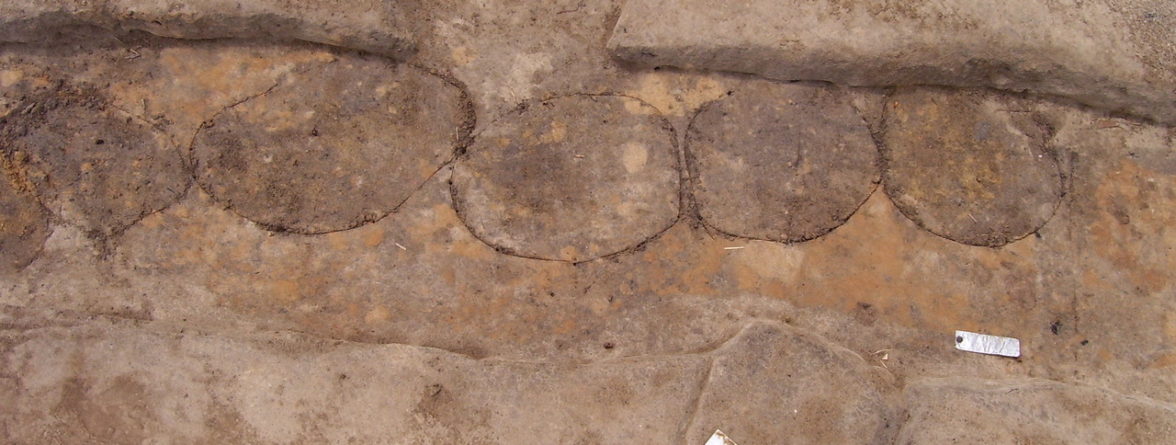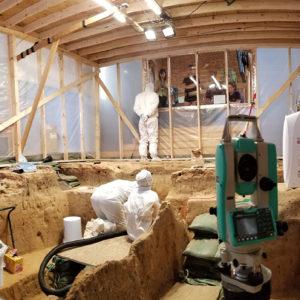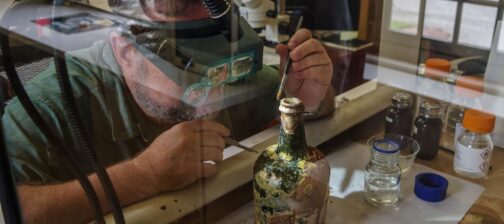In December 2013, the United Nations (UN) General Assembly designating December 5, 2014 as the first official World Soil Day.
After years of digging at James Fort, I often – and half-jokingly – refer to the archaeology team as “dirt surgeons.” But, all joking aside, “dirt” is the medium in which we operate the vast majority of the time. Archaeology is the surgical removal of the soil and debris from the past in a manner that can help us contextualize environmental, biological, and cultural activities. In the case of James Fort, soils can date to thousands of years ago, or be as recent as our own archaeological backfill.
When visitors encounter us out at the site and see us troweling the soil, we will often hear, “Wow, you guys are so careful and painstaking.” I point out to them that, in archaeology, we will use the biggest tool to get the job done right. For example, if we need to remove a gravel road or path—clearly modern features—we will use a backhoe to strip away the deposit. It should be noted that archaeologists don’t want to work any harder than anyone else, and I am an expert and careful backhoe operator!
The truth is, though, most of our time does involve carefully studying the soils and the processes that formed them in great detail. The way a feature (e.g., grave, ditch, cellar, well, &, etc.) is created, used, and eventually filled helps the archaeologists understand cultural actions on a site and is the basis for interpreting the past. The color, texture, and inclusions in the soil all help the archaeologists tell the story of what happened on a site. Then, if we are extremely lucky, archaeologists can come to understand when the activity occurred as well.
Another question the team will often hear is, “How did these things get buried so deeply?” The answer is complicated. They are usually looking at a deep cellar, road, or midden with some depth, and in those cases, the answer inevitably involves human activity. The colonists digging, dumping trash, and filling in unused features is usually the case. Before the colonists arrived, however, is a different story. Geologists have conveyed to the team that the “natural” accumulation of soil (wind bourne sand, build-up of vegetative debris, storm debris) results in, on average, about half an inch every fifty years if left undisturbed.
When archaeologists do find intact soils that predate the colonial settlement of Jamestown Island, the soil layers or stratigraphy tell a deeper story. For example, at James Fort, the team has found that First Peoples occupied the site for at least 8,000 years. The “natural” soil stratigraphy is composed of three layers or horizons. The top layer (usually around eight inches) contains organic debris mixed with cultural material generally consisting of pottery, stone tools, and calcined (burned) bone. Soil scientists classify this layer as an “A horizon.” Then, through the process of meteoric water, organic material and small particles leach out (E horizon) and accumulate as clay (B horizon). These three standardized layers provide the “backdrop” for the later colonial features, often drawing apparent differences between the two.
Soil can also contain tiny clues to the past as well. The team will regularly take archaeobotanical samples with the hopes of recovering phytoliths (the silicate “skeleton” of a plant), pollen, and carbonized seeds or plant tissue. These microscopic data can speak to past foodways and even give forensic clues that help identify an individual. For example, seasonal pollen in soil samples taken from a grave can suggest the time of year a person was buried. Combined with historical records, this information can either exclude or include specific individuals as the archaeology team works to create biological profiles of those they dig up.
So, as one can see, the title “dirt surgeon” is not too far off the mark. However, following this analogy out, an archaeologist must clearly understand the “patient” and the context of how the feature that they are studying came to be. And with much of the archaeology of James Fort and around the globe, the adage holds true: “it’s not what you find, it’s what you find out.”
– David Givens, Director of Archaeology for Jamestown Rediscovery.
related images
- The archaeology team “dirt surgeons” excavating the potential gravesite of Sir George Yeardley inside an “operating theater” constructed for the recovery of the remains.
- Excavations along the north side of the Jamestown Memorial Church. Archaeologists found evidence of a garden dated to the settlement’s first year.
- The archaeology team excavated this cellar which yielded thousands of artifacts dating to the early fort period, including evidence of cannibalism.
- Micro artifacts were recovered from the pulp chamber of a young boy killed in a skirmish with the Virginia Indians.









